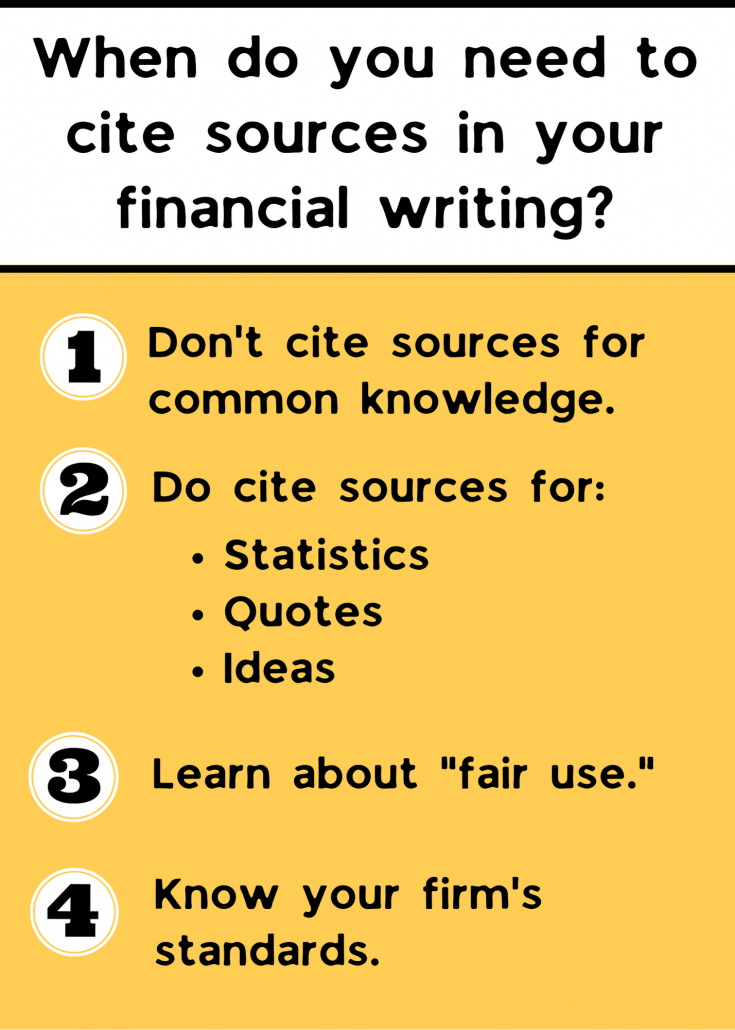When do you need to cite sources?
You don’t always need to say where you obtained the information you use in your writing. But sometimes it’s necessary for your credibility or to keep your firm’s compliance professionals happy. So, when do you need to cite sources in your blog, white paper, or other publication?

Common knowledge doesn’t require citing sources
If you’re citing a commonly known fact, you don’t need to know the source. For example, no one will ask you to document how you know that the U.S. has 50 states—not 49 or 51.
The same goes for somewhat more specialized yet broadly known statistics, such as “The estimated population of the U.S. is more than 330 million.” Still, if I were using that 330 million statistic, I’d probably do a Google search just to make sure the population hasn’t sneaked up to 340 million since I originally fixed that number in my mind.
Here’s a good discussion of “common knowledge” from Yale University’s Poorvu Center for Teaching and Learning.
Graphs and other depictions of numbers
It’s a good idea to provide sources for graphs and other exhibits derived from numbers. This information bolsters the credibility of your exhibits. It also satisfies your firm’s compliance professionals.
Sources usually go below the exhibit. For example, “Source: Bloomberg.” That’s a bare minimum citation. You may need to add more information about the source and the date of the data. Giving the date can be especially important when discussing economic or market data because the situation may have changed since the most recent published data.
The Chicago Manual of Style is a good source for how to treat that information. Don’t have a copy of the manual? Look at the guidelines for the CFA Institute’s Financial Analysts Journal or the Financial Planning Association’s Journal of Financial Planning.
Does your exhibit rely on data generated by your company? Document that, too, using “Source: YOUR COMPANY NAME.”
Quotes
Be careful to use accurate quotes. That’s especially true if you quote someone, but you’re relying on someone else’s repeating that quote from another source. That secondary source might have made a mistake. (I discovered this the hard way with my blog post quoting Woody Allen on the topic of success.)
Check that quote in the original source, if possible. Or, make it clear that you’re quoting someone else quoting that person. For example, “…as Warren Buffett said, according to L.J. Rittenhouse’s Buffett’s Bites: The Essential Guide to Warren Buffett’s Shareholder Letters.” If you use a famous quote, check its origins on the Quote Investigator website. You may be surprised by what you learn.
When you quote someone, give the person’s name and the source where you found the quotation. The detail that you provide will depend on the formality of where you’re publishing. An academic journal article requires a full footnote that may follow The Chicago Manual of Style. In a blog post, the person’s name and article title with a hyperlink to the article that you’re quoting may be enough.
If you wonder how much of a person’s writing you can quote, check out my post about fair use, which contains links to some great resources. Also, check to ensure that you’re not using proprietary data that you must license to use. I discussed one example of this in “Are you crediting your OECD data properly?”
Ideas
When you take ideas from other sources, even if you don’t quote them, you should name those sources. How much of an idea do you have to take before you need to attribute your idea to a source? The more distinctive the idea, and the more you take, the more likely that you should credit the source.
Again, check out my post about fair use for more on this topic.
Know your firm’s standards
Your firm’s compliance professionals may be able to share sourcing standards specific to your firm or their interpretation of the relevant SEC and other regulations.
You can save time on your interactions with compliance if you always source your key statistics and other information from outside sources. When I draft commentary for my clients, I usually footnote the sources of any statistics or interesting facts that I dig up, even if those footnotes aren’t necessary in the final, published product. This makes it easy for my clients to respond to sourcing-related challenges from compliance.
Compliance isn’t the only company function that may have opinions on your sourcing. Your marketing or editorial professionals may have a style guide or other standards that apply to your sourcing.
Disclosure: If you click on the Amazon link in this post and then buy something, I will receive a small commission. I link only to books in which I find some value for my blog’s readers.
Note: I updated this post on Sept. 30, 2022.
